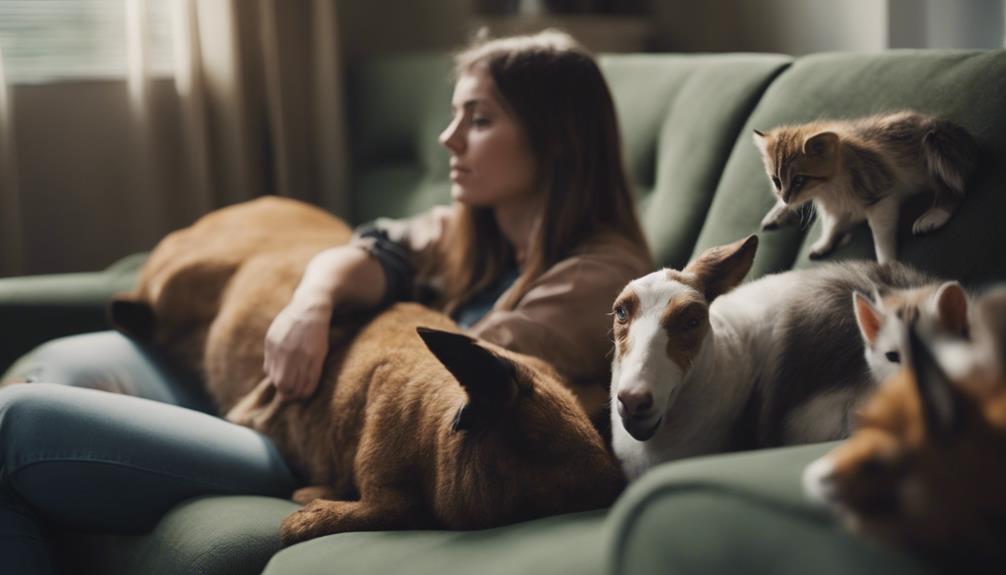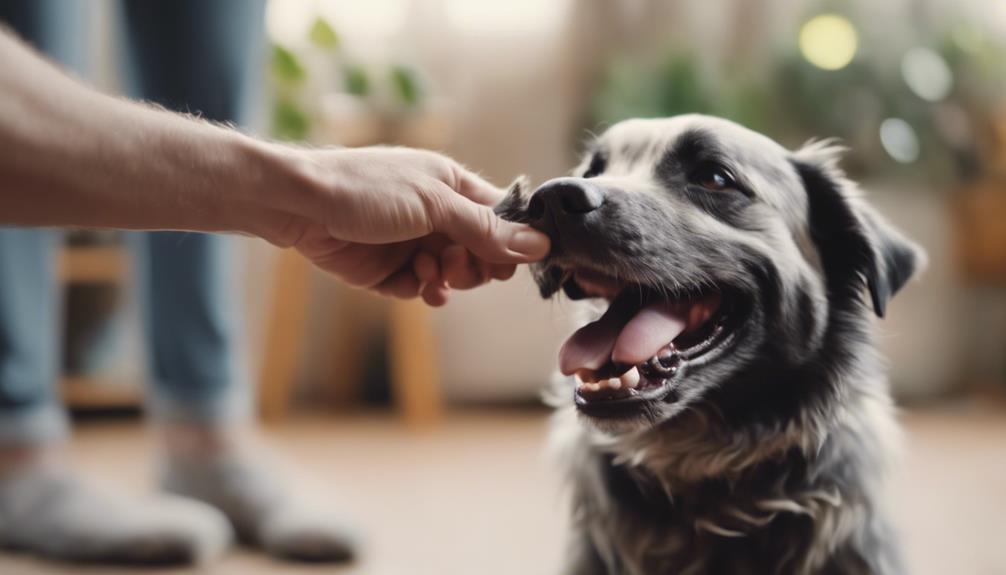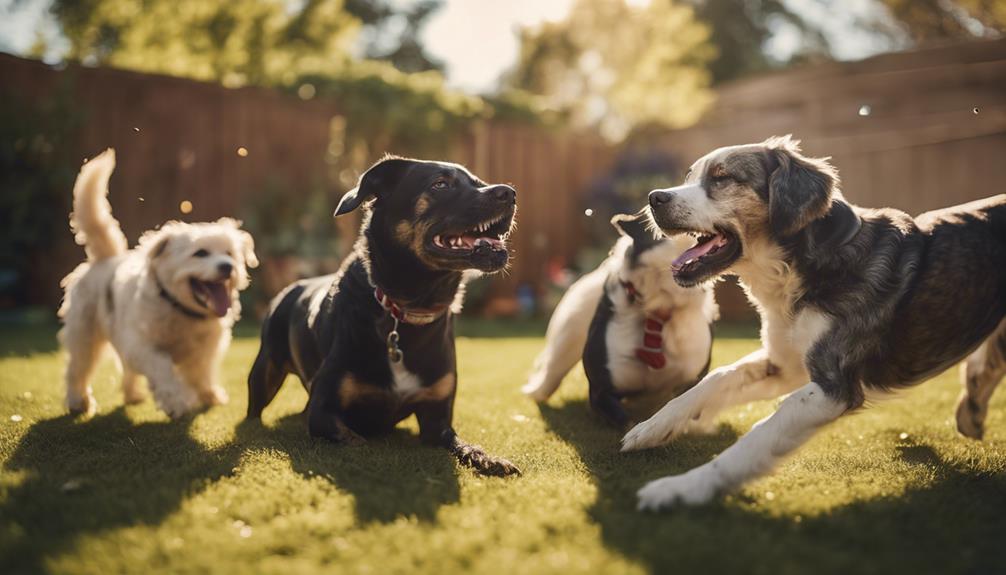As I navigate the intricacies of socializing adult rescues, a vital question often arises: how can we effectively help these furry companions adjust to their new environment?
The journey to build trust and create a sense of security for these adult rescues can be challenging yet profoundly rewarding. By following a structured approach and incorporating proven techniques, we can pave the way for a successful socialization process.
But what are these key strategies that can make a significant difference in transforming the lives of these adult rescues?
Key Takeaways
- Use body language cues and patience to build trust effectively.
- Approach slowly with soft tones and treats for positive associations.
- Implement clicker training and reward-based techniques for socialization.
- Seek professional support for tailored behavior modification and celebrate progress.
Understanding Adult Devon Rex Behavior

Have you ever wondered why adult Devon Rex cats behave the way they do? Understanding their body language cues is crucial in building trust.
These cats might initially display signs of fear or aggression due to past experiences, hindering their socialization progress. Through patience and behavior modification techniques, such as positive reinforcement and creating a safe environment, we can help them adapt to new situations.
Observing their responses to different stimuli can provide valuable insights into their emotional state and preferences. By respecting their boundaries and offering gentle encouragement, we can gradually help them feel more comfortable and secure.
Establishing a Safe Space
I notice that when it comes to adult rescues, creating a safe space is crucial.
Establishing clear boundaries and respecting their comfort zones can make a world of difference in helping them feel secure.
Safe Space Boundaries
Establishing a safe space for adult rescues involves setting clear boundaries to provide them with a sense of security and comfort as they adjust to their new environment. As they navigate this delicate period, it’s crucial to create a safe haven where they can feel secure and gradually build trust.
Here are some key points to consider:
- Consistent Routine: Establishing a predictable routine can help adult rescues feel more secure and build trust over time.
- Designated Safe Areas: Providing specific safe zones within the environment can give them a sense of control and security.
- Respect Personal Space: Allowing them to have their own space and respecting their boundaries is essential for their well-being.
- Clear Communication: Using positive reinforcement and clear communication helps them understand boundaries and expectations.
Comfort Zones Respect
Navigating the process of establishing a safe space for adult rescues involves recognizing and respecting their comfort zones to foster a sense of security. When interacting with adult rescues, it’s crucial to acknowledge their need for personal space. This could mean giving them the freedom to approach you on their terms, allowing them to retreat when feeling overwhelmed, and avoiding sudden movements that invade their space. Additionally, being mindful of time restrictions is essential. Understanding that adult rescues may need time to adjust to new surroundings and individuals can help build trust and comfort. By honoring their personal space and time boundaries, we create an environment where adult rescues can feel safe and gradually open up at their own pace.
| Respect Personal Space | Acknowledge Time Restrictions |
|---|---|
| Allow freedom to approach | Understand need for adjustment |
| Respect need to retreat | Be patient and give time |
Slow and Gentle Approach

Approaching adult rescues with patience and gentleness can help build trust and create a positive socialization experience for them. When interacting with these animals, it’s essential to remember their past experiences and potential traumas. Here are some tips to navigate this delicate process:
- Move slowly: Allow the rescue to approach you at their own pace.
- Use soft tones: Speak in a calm and soothing voice to reassure them.
- Avoid sudden movements: Sudden gestures can startle the rescue and hinder progress.
- Offer treats: Use treats as a way to create positive associations and encourage bonding.
Positive Reinforcement Techniques
Taking into account the need for positive reinforcement in socializing adult rescues, one can utilize reward-based training methods to encourage desired behaviors and strengthen the bond with the animal. Clicker training, a form of positive reinforcement, can be particularly effective in teaching adult rescues new behaviors and reinforcing good ones. By associating the sound of a clicker with a treat, the rescue can quickly learn what actions lead to rewards. When socializing adult rescues, paying attention to their behavioral cues is crucial. Understanding when they are comfortable, anxious, or curious can help tailor socialization techniques to suit their needs. Positive reinforcement, coupled with a keen eye for behavioral cues, can go a long way in making the socialization process smoother and more enjoyable for both the rescue and the caregiver.
| Positive Reinforcement Techniques |
|---|
| Clicker Training |
| Reward-Based Methods |
| Behavioral Cues |
| Tailored Socialization Techniques |
Patience and Consistency

Remaining patient and consistent is key when socializing adult rescues, as it allows for gradual progress and the establishment of trust between the animal and caregiver. It’s essential to understand that every small step forward is significant in the journey of socialization.
Here are some tips to help you navigate this process effectively:
- Celebrate Small Wins: Acknowledge and reward even the tiniest signs of progress.
- Establish Routine: Consistency in interactions and schedules helps build a sense of security.
- Listen and Observe: Pay attention to your rescue’s body language and responses to tailor your approach.
- Provide Safe Spaces: Create areas where your rescue can retreat to feel secure when overwhelmed.
Gradual Exposure to New Stimuli
To help adult rescues adjust comfortably, gradually introducing them to new stimuli at their own pace is crucial. Slow introduction is key in their socialization process. Each rescue has unique sensitivities and past experiences, so it’s essential to respect their individual comfort levels.
Gradual exposure to new experiences allows them to build confidence and trust in their environment. By observing their reactions closely, one can gauge the appropriate pace for introducing stimuli. It’s important to create a safe space where they can retreat if they feel overwhelmed.
Incorporating Playtime and Toys

When introducing playtime and toys to adult rescues, it’s important to consider their individual preferences and comfort levels. Observing their reactions can guide you in selecting the right toys and activities to encourage bonding and engagement.
Here are some tips to make playtime a positive experience for your rescue:
- Choose Interactive Toys: Opt for toys that allow you to play together, promoting bonding and trust.
- Rotate Toy Options: Keep things interesting by rotating toys regularly to maintain engagement and prevent boredom.
- Observe Their Reactions: Pay attention to how they interact with different toys to understand their preferences better.
- Encourage Playtime in Safe Spaces: Create a safe and comfortable environment where they can play freely and build confidence.
Encouraging Human Interaction
I find that using positive reinforcement techniques, such as rewarding good behavior with treats or praise, can help adult rescues feel more at ease around humans.
By setting boundaries together, like establishing a safe space where the rescue can retreat if feeling overwhelmed, we can create a sense of security for them.
Building trust slowly through patience and understanding is key to forming a strong bond with our adult rescues.
Positive Reinforcement Techniques
Encouraging human interaction with adult rescue animals can be effectively achieved through consistent positive reinforcement techniques. When working with your rescue, consider the following strategies:
- Clicker Training: Use a clicker to mark desired behaviors and follow up with treats for positive reinforcement.
- Treats: Reward good behavior with delicious treats to create positive associations with interactions.
- Body Language: Pay attention to your body language; approach calmly and use gentle movements to build trust.
- Praise: Offer verbal praise in a soothing tone to reinforce desired behaviors and create a bond.
Setting Boundaries Together
Understanding and respecting each other’s boundaries is crucial in fostering positive interactions between adult rescues and humans. Establishing boundaries creates a safe space where both parties can feel comfortable and respected. It’s vital to remember that adult rescues may have experienced trauma, so patience and empathy are key in this process. Mutual respect forms the foundation for a strong bond, allowing trust to grow over time naturally. Here is a table to help visualize the importance of setting boundaries together:
| Importance of Setting Boundaries Together |
|---|
| Helps create a safe and comfortable environment |
| Encourages mutual respect and understanding |
| Establishes clear communication channels |
| Builds trust and strengthens the bond |
| Promotes positive interactions and reduces stress |
Building Trust Slowly
Establishing a gradual approach to building trust with adult rescues involves allowing for natural interactions and positive reinforcement. When encouraging human interaction, it’s essential to remember that every step counts towards creating a lasting bond.
Here are some key points to keep in mind:
- Trust Building Exercises: Incorporate activities that promote trust and confidence gradually.
- Gradual Progress: Respect the pace at which the rescue feels comfortable, allowing for slow but steady progress.
- Respectful Interactions: Approach interactions with patience and understanding, showing respect for their boundaries.
- Emotional Bonding: Create a safe and nurturing environment where emotional connections can develop organically.
Seeking Professional Help if Needed
If you find that your adult rescue is struggling to adjust to social situations, consider reaching out to a qualified professional for guidance and support. Seeking professional help can provide valuable insights into behavior modification techniques tailored to your rescue’s specific needs. Expert advice and training techniques offered by professionals can make a significant difference in helping your rescue feel more comfortable and confident in social settings. Don’t hesitate to seek assistance if you notice persistent challenges or behaviors that seem beyond your expertise. Remember, it’s okay to ask for help, and doing so can lead to positive outcomes for both you and your rescue. Below is a table highlighting the benefits of seeking professional guidance:
| Benefits of Seeking Professional Help |
|---|
| Tailored Behavior Modification |
| Specialized Training Techniques |
| Expert Guidance and Support |
Celebrating Small Victories

After seeking professional help for my struggling adult rescue, I found that celebrating small victories played a crucial role in our journey towards socialization. Recognizing progress and building confidence became essential steps in helping my rescue overcome fears and insecurities.
Here are a few ways I celebrated these small victories:
- Setting achievable goals and acknowledging when they were met.
- Using positive reinforcement techniques to encourage desired behaviors.
- Documenting progress through photos or a journal to reflect on how far we’d come.
- Sharing achievements with friends and family to create a support network for both me and my rescue.
These small gestures of celebration not only boosted my rescue’s confidence but also strengthened our bond.




